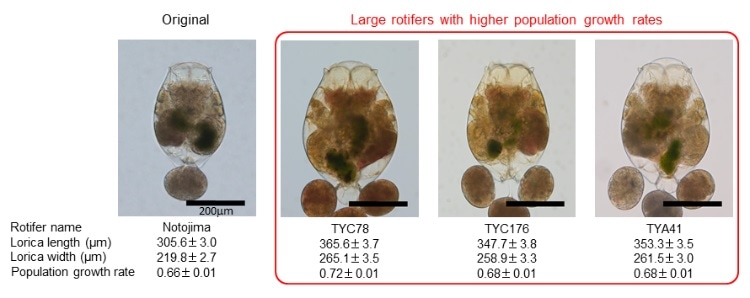A team of researchers, under the guidance of investigators from the RIKEN Nishina Center for Accelerator-Based Science (RNC), has effectively created larger-than-usual zooplankton strains by producing mutations with the help of a heavy-ion beam. These strains are utilized in fish nurseries.

Normal and mutant rotifers created with a heavy-ion beam. Image Credit: RIKEN.
The new zooplankton strains could play a key role in improving the growth of juvenile fish in aquaculture and enhancing their survival rate.
Live bait is fed to economically significant fish species, like flatfish, groupers, yellowtail, and bluefin tuna, until they are sufficiently big to be fed with artificial foods.
Rotifers are types of animal planktons that are generally utilized as the initial live food. Although fish require increasingly larger bait as they develop, rotifers are usually small and not sufficiently large to fulfill the needs of the growing fish. This results in growth abnormalities or cannibalism and ultimately lowers the rate of survival.
We decided to try to do something to improve the survival rate of fish larvae, as this would help to increase aquaculture productivity. We thought that if we could create a large rotifer strain using our expertise, it would contribute to stabilizing the income for aquafarmers.”
Tomoko Abe, Study Lead, RIKEN RNC
The study was published in the Bioscience, Biotechnology, and Biochemistry journal.
The research team, in association with the Japan Fisheries Research and Education Agency and Nagasaki University, started to experiment with a new method called heavy-ion beam irradiation in an effort to produce bigger rotifers.
Heavy-ion breeding is a method in which cells are subjected to a beam of heavy atomic nuclei, producing mutations relatively more effectively when compared to natural processes, like UV light.
By tuning the type of dose and ion, the beam is applied to cause arbitrary mutations in the genome, and strains with required phenotypes can be chosen.
Using analogous methods, the researchers have already developed extremely effective mutant lines of high-yielding rice oil-producing microalgae, and also a commercialized sake yeast.
The researchers used the RIKEN RI Beam Factory (RIBF) and irradiated the proliferating rotifers with beams of carbon and argon ions. They subsequently chose larger individuals and grew the plankton for many generations to produce a massive mutant line.
The size of the bred rotifers was around 1.2 times larger than that of other strains, which the researchers deemed to be a suitable size for growing juvenile fish. The team also observed that certain strains were both larger and grew more rapidly than the parent strains.
In general, larger mutants grow more slowly than normal rotifers, but we were lucky to discover a line that grows not only larger but faster as well. However, picking a large mutant among live rotifers that are moving quickly around under a microscope was far more difficult than we had anticipated and actually was the hardest part of this study.”
Tomoko Abe, Study Lead, RIKEN RNC
Food shortages caused by increased consumption and population growth are a key global concern, and nations across the globe are looking for new ways to boost the production of food. Ocean resources, which take up 70% of the surface area of Earth, can be a promising and effective solution to this issue.
Particularly, in Japan, being an island nation with a huge exclusive economic zone, boosting the production of marine resources is an attractive objective.
The enlarged rotifers acquired in this study may perhaps offer a consistent supply of low cost, larger rotifers, thus improving aquaculture.
Looking ahead, the researchers have now planned to utilize the larger rotifers in field tests to check if they can show better survival.
Source:
Journal reference:
Tsuneizumi, K., et al. (2021) Application of heavy-ion-beam irradiation to breeding large rotifer. Bioscience, Biotechnology, and Biochemistry. doi.org/10.1093/bbb/zbaa094.